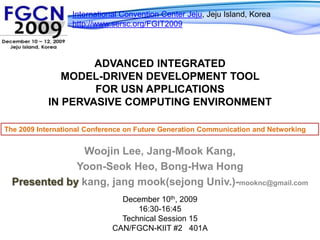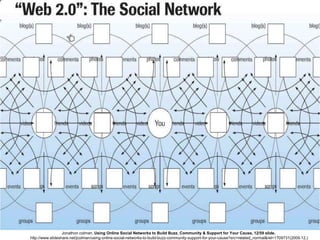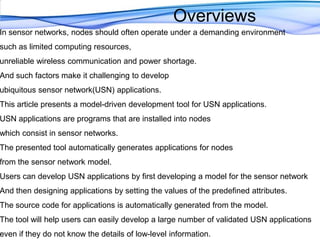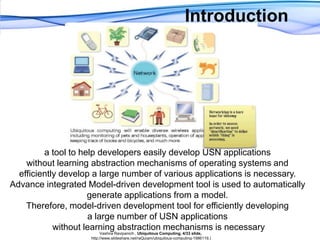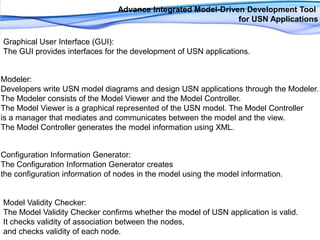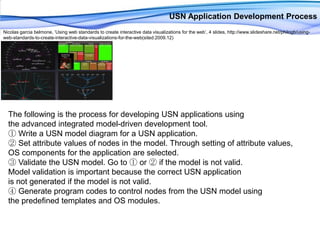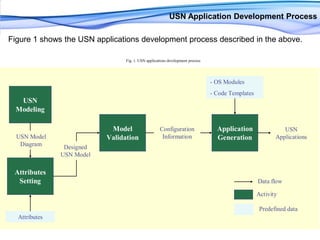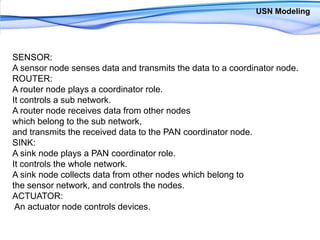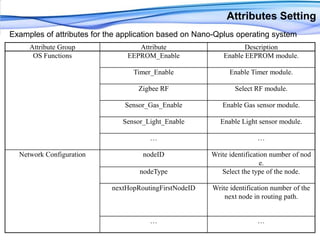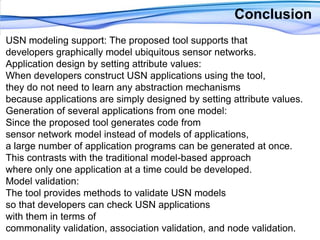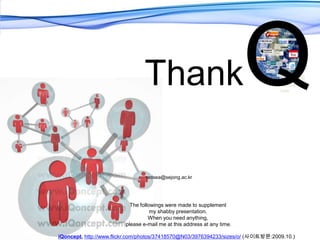Advanced Integrated Model-Driven Development Tool for USN Applications in Pervasive Computing Environment
- 1. International Convention Center Jeju, Jeju Island, Koreahttp://www.sersc.org/FGIT2009Advanced Integrated Model-Driven Development Tool for USN Applications in Pervasive Computing EnvironmentThe 2009 International Conference on Future Generation Communication and NetworkingWoojinLee, Jang-MookKang,Yoon-SeokHeo, Bong-HwaHongPresented by kang, jangmook(sejong Univ.)-mooknc@gmail.comDecember 10th, 200916:30-16:45Technical Session 15CAN/FGCN-KIIT #2 401A
- 2. Jonathon colman, Using Online Social Networks to Build Buzz, Community & Support for Your Cause, 12/59 slide, http://www.slideshare.net/jcolman/using-online-social-networks-to-build-buzz-community-support-for-your-cause?src=related_normal&rel=1709731(2009.12.)
- 3. OverviewsIn sensor networks, nodes should often operate under a demanding environment such as limited computing resources, unreliable wireless communication and power shortage. And such factors make it challenging to develop ubiquitous sensor network(USN) applications. This article presents a model-driven development tool for USN applications. USN applications are programs that are installed into nodes which consist in sensor networks. The presented tool automatically generates applications for nodes from the sensor network model. Users can develop USN applications by first developing a model for the sensor network And then designing applications by setting the values of the predefined attributes. The source code for applications is automatically generated from the model. The tool will help users can easily develop a large number of validated USN applications even if they do not know the details of low-level information.
- 4. Introductiona tool to help developers easily develop USN applications without learning abstraction mechanisms of operating systems and efficiently develop a large number of various applications is necessary. Advance integrated Model-driven development tool is used to automatically generate applications from a model. Therefore, model-driven development tool for efficiently developing a large number of USN applications without learning abstraction mechanisms is necessaryVashiraRavipanich , Ubiquitous Computing, 4/33 slide, http://www.slideshare.net/raQuiam/ubiquitous-computing-1986119.)
- 5. Advance Integrated Model-Driven Development Tool for USN ApplicationsGraphical User Interface (GUI): The GUI provides interfaces for the development of USN applications.Modeler: Developers write USN model diagrams and design USN applications through the Modeler. The Modeler consists of the Model Viewer and the Model Controller. The Model Viewer is a graphical represented of the USN model. The Model Controller is a manager that mediates and communicates between the model and the view. The Model Controller generates the model information using XML.Configuration Information Generator: The Configuration Information Generator creates the configuration information of nodes in the model using the model information. Model Validity Checker: The Model Validity Checker confirms whether the model of USN application is valid. It checks validity of association between the nodes, and checks validity of each node.
- 6. Advance Integrated Model-Driven Development Tool for USN ApplicationsSource Code Generator: The Source Code Generator creates C source files of nodes using the predefined templates and the configuration information generated by the Configuration Information Generator.Target Image Generator: The Target Image Generator constructs ROM image fileswhich are installed into nodes by compiling the C source files. The ROM image files are generated by reflecting the hardware platform of nodes in the sensor network.Templates Storage: The Templates Storage stores predefined templates for the generation of source codes of nodes. Modules and code templates, which are provided by target operating system, are stored in the Template Storage.
- 7. USN Application Development ProcessNicolas garciabelmone, ‘Using web standards to create interactive data visualizations for the web’, 4slides, http://www.slideshare.net/philogb/using-web-standards-to-create-interactive-data-visualizations-for-the-web(sited:2009.12) The following is the process for developing USN applications using the advanced integrated model-driven development tool.① Write a USN model diagram for a USN application.② Set attribute values of nodes in the model. Through setting of attribute values, OS components for the application are selected.③ Validate the USN model. Go to ① or ② if the model is not valid. Model validation is important because the correct USN application is not generated if the model is not valid. ④ Generate program codes to control nodes from the USN model using the predefined templates and OS modules.
- 8. USN Application Development ProcessFigure 1 shows the USN applications development process described in the above.
- 9. USN ModelingThe notation of the USN model
- 10. USN ModelingSENSOR: A sensor node senses data and transmits the data to a coordinator node. ROUTER: A router node plays a coordinator role. It controls a sub network. A router node receives data from other nodes which belong to the sub network, and transmits the received data to the PAN coordinator node. SINK: A sink node plays a PAN coordinator role. It controls the whole network. A sink node collects data from other nodes which belong to the sensor network, and controls the nodes. ACTUATOR:An actuator node controls devices.
- 11. Attributes SettingExamples of attributes for the application based on Nano-Qplus operating system
- 12. Model ValidationCommunication between nodes should be performed without any problems. Data should be transmitted to the server through the correct path which is determined by designer of the sensor network model. Applications should be designed by accepting constraints according to the role of each node. Applications should be designed by accepting constraints of target platform
- 13. Code Generation
- 14. Conclusion USN modeling support: The proposed tool supports that developers graphically model ubiquitous sensor networks.Application design by setting attribute values: When developers construct USN applications using the tool,they do not need to learn any abstraction mechanisms because applications are simply designed by setting attribute values.Generation of several applications from one model: Since the proposed tool generates code from sensor network model instead of models of applications, a large number of application programs can be generated at once. This contrasts with the traditional model-based approach where only one application at a time could be developed.Model validation: The tool provides methods to validate USN models so that developers can check USN applications with them in terms of commonality validation, association validation, and node validation.
- 15. ReferencesCY Chong, and SP Kumar, “Sensor networks: evolution, opportunities, and challenges,” Proceedings of the IEEE, vol. 91, no. 8, pp. 1247– 1256, Aug. 2003.Eric Clayberg and Dan Rubel, Eclipse: Building Commercial- Quality Plug-ins, Addison Wesley, 2004.Bill Moore, David Dean, Anna Gerber, Gunnar Wagenknecht, and Philippe Vanderheyden, Eclipse Development, International Business Machines Corporation, 2004.Karen Patten and KatiaPasserini, “From personal area networks to ubiquitous computing: preparing for a paradigm shift in the workplace,” Proc. Wireless Telecommunications Symposium, pp. 225-233, IEEE CS Press, 2005.Kwangyong Lee et al., “A Design of Sensor Network System based on Scalable & Reconfigurable Nano-OS Platform,” Proc. IT SoC Conf., pp. 344-347, 2004. ETRI Embedded S/W Research Division, “Nano-Qplus,” http://qplus.or.kr/"TinyOSPlugin for Eclipse," http://www.dcg.ethz.ch/~rschuler/ETRI Embedded S/W Research Division, "NanoEsto," http://qplus.or.kr/D. Gay, P. Levis, R. von Behren, M.Welsh, E.Brewer, and D. Culler, "The nesC language: A holistic approach to networked embedded systems," Proc. ACM SIGPLAN 2003 Conf. on Programming Language Design and Implementation (PLDI’03), pp. 1-11, ACM Press, 2003.“LabVIEW for Embedded Development,” http://www.ni.com/pdf/products/us/ 2005-5554-821-101-LO.pdfhttp://www.pragmadev.com/index2.html
- 16. ThankQredsea@sejong.ac.krThe followings were made to supplement my shabby presentation. When you need anything, please e-mail me at this address at any time.iQoncept, http://www.flickr.com/photos/37418570@N03/3976394233/sizes/o/ (사이트방문:2009.10.)
